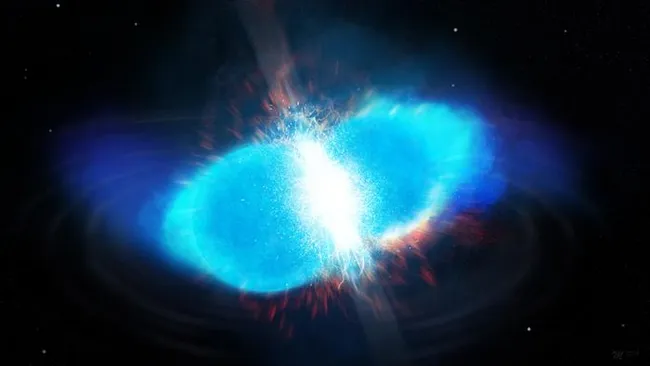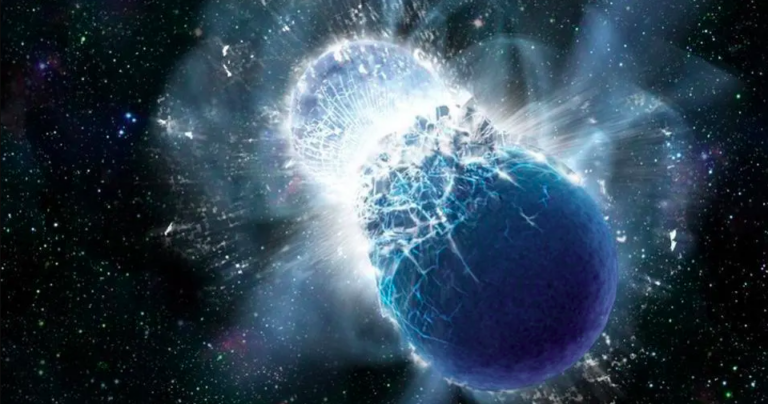First-Ever Observation of Cosmic Nuclear Fission Unveiled in ‘Exceptionally Profound’ Revelation
“With our increasing observations, the universe is signaling, ‘Look, there’s a distinct signature here, unmistakably linked to fission.'”
Scientists have made a groundbreaking discovery, finding the initial evidence of nuclear fission taking place within celestial bodies. This revelation bolsters the theory that when neutron stars collide, they produce “superheavy” elements exceeding the heaviest elements on the periodic table. These elements subsequently undergo nuclear fission, yielding materials such as the gold found in jewelry.

In essence, nuclear fission stands in contrast to nuclear fusion. While fusion involves the fusion of lighter elements to form heavier ones, fission involves the splitting of heavy elements, releasing energy and forming lighter elements. Nuclear fission is a well-known process, serving as the fundamental principle behind energy-producing nuclear reactors on Earth. However, its occurrence in celestial bodies had not been observed until now.
Matthew Mumpower, a scientist at Los Alamos National Laboratory and co-author of the research, stated, “There have been suggestions that fission might be occurring in space, but until now, there hasn’t been conclusive evidence.”
Under the guidance of Ian Roederer, a scientist from North Carolina State University, a team of researchers examined stellar data encompassing various elements. Their investigation unearthed the initial proof indicating the potential involvement of nuclear fission during the merging of neutron stars. These revelations may offer insights into the origins of heavy elements in the universe, addressing a longstanding cosmic enigma.
Scientists have long recognized nuclear fusion as the primary energy source for stars, responsible for producing various elements, with iron being among the heaviest.
However, the mechanism behind the formation of heavier elements like gold and uranium has remained enigmatic. It’s believed that these rare heavy elements are generated when extremely dense remnants of dead stars—neutron stars—collide and merge, creating an environment of extreme violence capable of forging elements unattainable even within the most tumultuous stellar cores.
The discovery of nuclear fission, as revealed by Mumpower and the team, is evidenced by a correlation observed between “light precision metals,” such as silver, and “rare earth nuclei,” like europium, within certain stars. The team noticed that when one group of these elements increases, the corresponding elements in the other group also experience a rise.
Moreover, the team’s research suggests the potential existence of elements with atomic masses exceeding 260 around neutron star collisions, albeit fleetingly. This surpasses the weight of many elements found at the upper range of the periodic table.
Mumpower emphasized, “The only conceivable way for this to occur across different stars is if a consistent process is at work during the creation of heavy elements. This discovery is immensely significant and marks the initial confirmation of fission operating within the cosmos, affirming a theory we proposed years ago.”
“With our expanding observations, the cosmic message is clear: ‘There’s a distinct signature here, one that unequivocally points to fission.'”
Neutron stars and nuclear fission
Neutron stars come into being as colossal stars exhaust their fuel, halting the intrinsic nuclear fusion that sustains them against their own gravitational force. Consequently, as the outer layers of these dying stars disperse, the cores—ranging from one to two times the mass of our sun—shrink into a compact zone roughly 12 miles (20 kilometers) wide.
This rapid core collapse causes electrons and protons to merge, forming an immensely dense sea of neutrons. Just a spoonful of this neutron star “substance” would weigh over 1 billion tons on Earth.
In binary systems, these extreme stars orbit each other, emitting gravitational waves that diminish their angular momentum. Eventually, these neutron stars collide, creating an intensely violent environment.
The resulting merger releases a surplus of free neutrons, typically bound within atomic nuclei. These free neutrons swiftly combine with other atomic nuclei, a process known as rapid neutron capture or the “r-process,” leading to the creation of heavier atomic nuclei, forming unstable superheavy elements. These elements can subsequently undergo fission, breaking down into stable, lighter elements like gold.
In 2020, Mumpower predicted the distribution of “fission fragments” from r-process-formed nuclei. His collaborator, TRIUMF scientist Nicole Vassh, calculated how the r-process would generate light precision metals such as ruthenium, rhodium, palladium, and silver, alongside rare earth nuclei like europium, gadolinium, dysprosium, and holmium.
This forecast can be tested not only through observations of neutron star mergers but also by analyzing element abundances in stars enriched by r-process materials. The recent study examined 42 stars and confirmed the precise correlation anticipated by Vassh, providing a distinct indication of the fission and decay of elements heavier than those found on the periodic table. This further validates that neutron star collisions are indeed the celestial forges for elements heavier than iron.
“The correlation stands strong in stars with enriched r-process content and sufficient data. Each occurrence of a silver atom corresponds to a proportional increase in heavier rare earth nuclei. The compositions of these elements progress in sync,” concluded Mumpower. “Our findings point to a single mechanism at play—fission—a puzzle scientists have pondered since the 1950s.”
The team’s research was published in the Dec. 6 edition of the journal Science.
This article is republished from SpaceCom under a Creative Commons license. Read the original article.
Do not forget to share your opinion with us to provide you with the best posts !




0 Comments